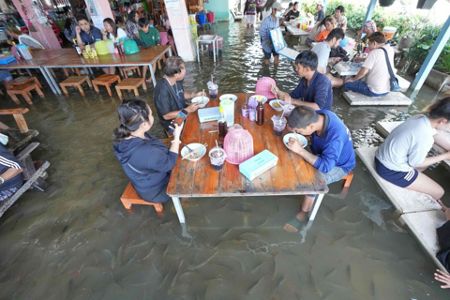Thai Riverside Restaurant Turns Flooded Floor into Fish-Filled Attraction

Rising river waters bring live fish right to diners’ feet
At Pa Jit, a small riverside restaurant west of Bangkok, flood season has turned into peak season. When the Tha Chin River overflows, fish slip through the floor and swim between the tables, brushing past customers’ feet as they eat. What might sound like a nightmare for most restaurant owners has become Pa Jit’s unlikely calling card. Families travel in from surrounding provinces to take photos, shoot videos and let their children squeal as silver flashes dart through the ankle-deep water.
The restaurant, located in Nakhon Pathom province about 30 kilometres from the capital, has been in business for more than three decades. Owner Pornkamol Prangprempree recalls that the first time water surged in several years ago, she feared the worst. She assumed regulars would stay away and the business would sink with the rising river. Instead, a customer posted a clip online of fish gliding between plastic stools and metal tables. The video went viral, and suddenly queues formed outside for a chance to dine with the river literally at their feet.

Staff have learned to adapt to the new reality. Waiters now wear waders or shorts as they balance steaming bowls of fish soup and chicken noodles across the flooded floor. Diners are encouraged to wear sandals and leave valuables above water level. Buckets of fish food are available so children can drop pellets into the water and watch catfish and carp swarm. The atmosphere is closer to a riverside fairground than a traditional eatery, with phones held aloft and laughter echoing over the slosh of water.
Subhead 2 (climate risk and community resilience)
Behind the social-media spectacle lies a more serious backdrop of changing weather patterns and frequent flooding across Thailand’s central plains. Seasonal overflows are nothing new along the Tha Chin, but residents say heavy rains and altered river management have made high-water events more common. In many communities, rising waters mean lost crops and damaged homes. Pa Jit’s story stands out because it shows one small business turning unavoidable floods into a creative, if temporary, advantage.
Local authorities monitor water levels and warn that safety comes first. The restaurant operates only when currents are slow and the water is shallow enough for customers to move around easily. If levels rise too high or debris enters the dining area, service is paused. Health officials also stress the need for proper cleaning and food-handling to avoid contamination. For now, though, visitors say the experience feels less like a hazard and more like an unusually immersive meal—part nature encounter, part tourism stunt.
Bangkok-area residents, who already live with regular street flooding, seem particularly drawn to the novelty. Parents say the restaurant offers an easy way to teach their children about rivers and ecosystems without travelling far from the city. Some environmentalists worry that normalising everyday flooding could distract from long-term adaptation needs, from upgraded drainage to stronger river embankments. Yet they also acknowledge that businesses like Pa Jit help people cope emotionally with a climate that is already changing around them.
For Pornkamol, the balancing act is simple: respect the river, keep customers safe and serve good food. She says she never planned to become famous for having fish in her aisles, but she understands why the images resonate. The water, she notes, is both a threat and a lifeline—feeding the fish, feeding the rice fields and now, in an unexpected way, feeding her restaurant’s future.






















